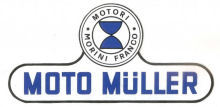


A Brief History of the Italian Marque
Scuza Itanglish
Bruno Müller e triestino con ascendenze austriache ma motociclisticamente bolognese, la città dove ha aperto il suo officina-laboratorio. Müller è soprattutto conosciuto per le moto da fuoristrada costruite dal 1968 al 1979 in territorio bresciano. Moto per le quali ha impiegato motori Zündapp, Hiro, Sachs, Franco Morini, Minarelli Bultaco e Villiers con cilindrate da 50 a 250 cc.
In realti la produzione Müller vanta anche un periodo in cui il costruttore ha realizzato, nella sua officina di Bologna, motoleggere da strada dal 1950 al 1956 impiegando motori NSU 125 DB a due tempi, nel 1950, e poi NSU 98 a quattro tempi.
All'inizio il tecnico triestino aveva anche approntato una piccola serie di motoleggere da strada con propulsore Alpino 125 a due tempi. Sembra che la Alpino avesse fornito a Müller duecento motori. Nel 1953 una Müller con motore 125 a due tempi, forse Alpino o NSU, risulta iscritta alla Milano-Taranto e l'anno dopo una Müller-NSU partecipa al Motogiro. Il tecnico triestino realizza anche moto da strada con propulsore Sachs 150 e NSU Lux 200, con una di queste moto Bruno Müller, era anche buon pilota, vince nel 1953 il trofeo italiano di regolarità. Utilizza anche motori Ibis e Veggetti.
Nel 1954 col marchio Müller viene presentato il ciclomotore Pony, in versione turismo e sport, equipaggiato con motore NSU Quickly. Vengono anche costruite alcune moto impiegando il prestigioso motore NSU Max di 250 cc con distribuzione monoalbero comandato da biellette, una di queste viene trasformata in moto da cross e con questa il costruttore-pilota effettua alcune gare. Nel 1956 termina il periodo bolognese e, dopo una breve parentesi lavorativa alla Montagnoli di Verona, approda a Torino alle Officine Viberti nel 1957, dove si interessa alla produzione del ciclomotore ViVi.
Nel 1963 Müller ritorna alla ViVi, che ora ha gli stabilimenti a Pontevico in provincia di Brescia, e collabora alla progettazione del modello Sport, presentato al Salone di Milano del 1963, del ViVi Gran Turismo con forcella telescopica e del modello Totalmatic 48 con cambio automatico a due velocite. L'ultimo lavoro del brillante progettista per la ViVi e il modello Sport Special presentato al Salone di Milano del 1965. Negli anni seguenti Müller costruire apprezzate, e oggi ricercate, moto da fuoristrada nella sua officina a Robecco sull'Oglio in provincia di Brescia. Esiste anche un periodo germanico perche, nel 1968, Mü ller costruisce moto a Monaco di Baviera. Termina l'attivite nel 1979 quando passa a progettare e costruire deltaplani e velivoli ultraleggeri.
Bruno Müller built motorcycles in Italy and Germany from 1950 to c.1979.
Of Austrian heritage, Müller of Trieste established his first workshop in Bologna, in 1950, before moving to Turin in 1957.
Müller is known primarily for off-road motorcycles built from 1968 to 1979 in the Brescia area using engines from Zundapp, but he also used powerplants with displacements of 50 to 250cc from Hiro, Sachs and others. (List below)
From 1950-1956 the Moto Müller company built, in its Bologna workshop, light road motorcycles using NSU DB 125 two-stroke engines and NSU 98cc four-strokes.
It is believed that Alpino had supplied Müller with two hundred 125cc engines. In 1953 a Müller with a 125 two-stroke engine, either from Alpino or NSU, was registered for the Milano-Taranto run, and the following year a Müller-NSU participated in the Mototour. The Trieste firm also constructed road motorcycles with Sachs 150 and NSU 200 Lux engines, one of which won the 1953 Italian enduro trophy. They also use Ibis and Veggetti engines.
In 1954 the Pony moped was released in Turismo and Sport versions equipped an NSU Quickly engine. Some motorcycles were also built using the prestigious OHC 250 cc NSU Max engine. A Max machine was developed for off-road competition and with it Bruno won several races.
In 1963, Müller returned to ViVi, which by then had plants in Pontevico in the province of Brescia, and helped design the Sport model. This was presented at the Milan Show in 1963, along with the ViVi Gran Turismo with telescopic fork and Totalmatic 48 model with automatic two-speed transmission.
The last ViVi project of the brilliant designer was the Sport Special, presented at the Milan Fair of 1965. In the following years Müller built off-road motorcycles in his workshop in Robecco sull'Oglio in the province of Brescia. These machines are now in considerable demand, it is understood.
In 1968, Müller built motorcycles in Monaco di Baviera (Munich). The company ended motorcycle production in 1979 and began designing and building gliders and ultralight aircraft.
Cristina Muller, Bruno Muller's daughter, was a skilled enduro rider, and those who knew her have kind words - "a nice and funny girl", says one Italian correspondent.
Paolo Scaramuzza, a former Muller rider, has an example of the PCR with the exhaust port at the rear and the carburettor and air filter on the side of the cylinder.
Bultaco - very limited production
Franco Morini Motori
Ibis
Laverda - only two 420cc machines were built
Montesa
NSU
PCR kart engine
Sachs
Minarelli (possibly)
Villiers
Zundapp
Sources: Moto di Lombardia, Tragatsch p222, correspondence.
If you have a query about Moto Muller of Bologna please contact us